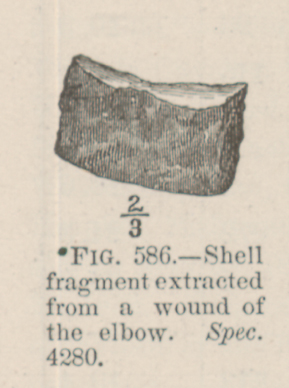Title: Ellsworth, E. A.
Source text: The Medical and Surgical History of the War of the Rebellion. (1861-65.), Part 2, Volume 2 (Washington, DC: Government Printing Office, 1876), 830.
Civil War Washington ID: med.d2e30526
TEI/XML: med.d2e30526.xml
CASE 1740.—First Lieutenant E. A. Ellsworth, Co. D, 11th Infantry, aged 24 years, was wounded at Bethesda Church, June 1,1864. Two days afterward he reached the Fifth Corps Hospital at White House, and, on June 7th, he entered Harewood Hospital, Washington. Surgeon D. W. Bliss, U. S. V., reported: "Gunshot wound of right arm. Patient transferred to private residence on June 13th" The missile, represented in the annexed cut (FIG. 586), is a small triangular fragment of a shell weighing two hundred and five grains troy; remarkable for having furnished lustre to a porcelain bulb though of cast iron. It was contributed to the Museum by Assistant Surgeon J. S. Smith, U. S. A., who reported: "The missile struck the ulna of the right arm about one and a half inches from the elbow joint, fracturing the bone transversely at the point of contact and rending it into long splinters in its length. The presence of the missile was revealed by the Nélaton probe about midway of the ulna, between the long spiculæ." In a report of observations by Assistant Surgeon J. S. Billings, U. S. A., to the Medical Director of the Army of the Potomac, mention is made of this case as follows: "Lieutenant Ellsworth was wounded by a minié ball, which passed through the upper and outer portion of the right ulna, the fracture extending into the elbow joint. The smaller fragments and spiculæ were removed by Assistant Surgeon J. S. Smith, U. S. A., and two large and firmly attached fragments, one joined to the upper, the other to the lower fractured end, were left in situ. Simple cold-water dressings were applied. This officer went to Washington, and was treated by Surgeon B. Norris, U. S. A. Two months afterward the wound had almost entirely healed, motion was good in the joint, although somewhat limited, and the deformity of the arm was slight. Only three small spiculæ of bone came away." Lieutenant Ellsworth resigned his commission on December 18, 1866, and was pensioned. Examiner W. W. Potter, April 19, 1869, certified: "Fracture of right ulna near elbow joint, caused by a shell. * * * The head of the radius appears displaced and the limb is deformed. The muscles are atrophied; extension cannot be completely made; pronation and supination are imperfect; strength of limb destroyed for any purpose of labor." The pensioner was paid on March 4, 1875.
